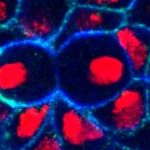Lien vers HAL – pasteur-04607553
Lien DOI – 10.1101/2024.03.11.583933
2024
Lateral inhibition by Notch mediates the adoption of alternative cell fates amongst groups of initially equipotent cells, leading to the formation of regular patterns of cell fates in many tissues across species. Genetic and molecular studies have established a model whereby an intercellular negative feedback loop serves to amplify small stochastic differences in Notch activity, thereby generating ordered salt-and-pepper patterns. In Drosophila , lateral inhibition selects Sensory Organ Precursor cells (SOPs) from clusters of proneural cells that are competent to become neural through the expression of proneural transcription factors. When and how symmetry breaking occurs during lateral inhibition remains, however, to be addressed. Here, we have used the pupal abdomen as an experimental model to study the dynamics of lateral inhibition in Drosophila . Using quantitative live imaging, we monitored the accumulation of the transcription factor Scute (Sc), used as a surrogate for proneural competence and adoption of the SOP fate. We found that fate symmetry breaking occurred at low Sc levels and that fate divergence was not preceded by a prolonged phase of low or intermediate level of Sc accumulation. The relative size of the apical area did not appear to bias this fate choice. Unexpectedly, we observed at low frequency (10%) pairs of cells that are in direct contact at the time of SB and that adopt the SOP fate. These lateral inhibition defects were corrected via cellular rearrangements. Analysis of Sc dynamics in wild-type and genetically mosaic pupae further revealed that cell-to-cell variations in Sc levels promoted fate divergence, thereby providing experimental support for the intercellular negative feedback loop model.

